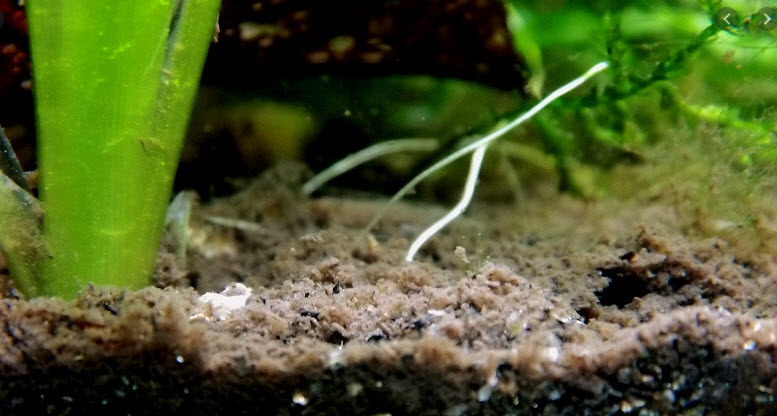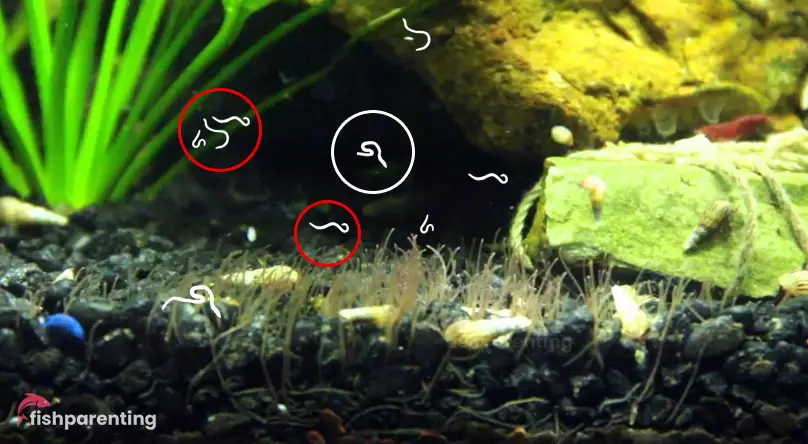Detritus is organic matter that accumulates on the bottom of an aquarium. It consists of dead plant and animal material, as well as fecal waste and other debris. In a healthy aquarium, detritus is consumed by scavengers such as snails and shrimp.
These organisms consume decomposing organic material for food, which helps to keep the tank clean. Other organisms such as corydoras cats will also eat detritus from the substrate in order to supplement their diet. Certain species of fungus can also help break down detritus into usable nutrients for plants growing in the tank.
When it comes to cleaning up detritus, algae-eating fish are extremely helpful since they spend much of their time grazing off of surfaces like rocks and decorations where bits of food or waste may accumulate over time.
Detritus, or organic debris, is an important part of any aquarium’s ecosystem. Detritus provides food for a variety of aquatic organisms such as worms and shrimp. Substrate-dwelling critters like snails, crabs, and sea stars also eat detritus in addition to scavenging for pieces of uneaten fish food.
Invertebrates like flatworms can break down the detritus into smaller particles that other creatures can then feed on. There are even some species of fish that will supplement their diet by eating small amounts of detritus from the substrate! A healthy aquarium should have a good balance between the amount of detritus being produced and the number of animals consuming it to ensure that nothing becomes overabundant or detrimental to tank health.

Credit: aquariumscience.org
How Do I Get Rid of Detritus in My Aquarium?
Cleaning your aquarium of detritus is essential for keeping your fish healthy and the water crystal clear. Detritus, or organic waste, is made up of uneaten food, fish excretions, decaying plants and other debris that accumulates in the tank over time. Removing it regularly can help maintain a clean environment for your aquatic creatures, so here are some tips on how to get rid of detritus in your aquarium:
1) First off, you should do regular partial water changes at least once a week. This removes dissolved nutrients from the tank as well as any small pieces of detritus that may have accumulated over time. Additionally, you should use an appropriate filter with media such as activated carbon or zeolite which can absorb additional particles floating around in the tank.
2) Vacuum gravel beds to remove larger pieces of debris like leftover foods that haven’t been eaten by fish or decaying plant material. Avoid using sharp implements when doing this though – gentle vacuuming will be enough to do the job without disturbing any beneficial bacteria living in your substrate layer!3) Consider adding snails or other scavengers into your tank who will eat away at some of the detritus left behind by your fish and plants.
These animals also serve another purpose – they aerate and clean rocks which helps keep oxygen levels high within the system!
What Eats Detritus in Freshwater?
Detritus is a broad term used to describe any organic material that has been broken down by decomposition. In freshwater systems, detritus is an important component of the food web because it provides essential energy and nutrients for many organisms. One group of animals that feed on detritus are the benthic macroinvertebrates – small aquatic insects, crustaceans and worms that live in or near the sediment at the bottom of rivers and lakes.
These creatures are very efficient at breaking down large pieces of dead leaves or animal matter into smaller particles which can then be consumed by other animals in the ecosystem such as fish or amphibians. Additionally, fungi play an important role in consuming detritus as well; they secrete enzymes to break down tougher materials like woody debris and leaf litter before absorbing their nutrients into their cells. Other scavengers such as crayfish, crabs and snails also consume large pieces of detrital matter while filter-feeders like clams strain out tiny particles from passing water currents to feed upon.
All these critters play a key role in keeping our freshwater ecosystems healthy by recycling essential nutrients back into circulation through their consumption of detrital matter!
Do Snails Eat Detritus in Aquarium?
Snails are one of the most popular inhabitants in aquariums. They come in a variety of shapes and sizes, from small to large. But despite their popularity, many people don’t know much about these fascinating creatures.
One question that is often asked is: do snails eat detritus in aquariums? The answer is yes! Snails are scavengers and will happily feed on any organic matter they find at the bottom of your tank, including dead plant material and other forms of detritus such as uneaten fish food or decaying algae.
Not only do snails help keep tanks clean by consuming debris, but they also provide valuable nutrients to other organisms living inside the aquarium. In addition to being able to survive off detritus, some species may supplement their diet with live plants or even meaty foods like brine shrimp or bloodworms if offered them – however this should be done sparingly as overfeeding can lead to water pollution which can harm other aquatic life. So while it’s true that snails will eat detritus in an aquarium setting, it’s important to remember not to overfeed them so that your tank remains healthy for all its inhabitants!
What Freshwater Snails Eat Detritus?
Freshwater snails are an important part of the aquatic ecosystem, providing food for many other species and helping to keep the water clean by consuming detritus. Detritus is organic matter that accumulates in a body of water, such as dead plants and animals, algae, sediment particles, and waste from humans or animals. Freshwater snails feed on this material with their specialized radula – a tongue-like organ equipped with hundreds of tiny teeth – scraping off bits of detritus while they search for food.
The snail’s diet consists mainly of bacteria that grow on the surface of these organic particles. They will also consume algae and other plant material when available but prefer decaying animal matter due to its higher nutritional value. In addition to their role in breaking down detritus in the environment, freshwater snails also provide food for fish, amphibians, reptiles, birds and mammals including otters!
How to get rid of Detritus Worms in your tank naturally – Feeding time for Endlers ᴴᴰ
What Eats Detritus in Sump
Detritus is a critical food source for many organisms living in sump ecosystems. Many species of fish, invertebrates, and aquatic plants are known to feed on detritus, including scavengers such as shrimp, snails, worms and crabs. Other filter-feeding animals like clams can also help to break down the detritus into more digestible particles.
Even bacteria play an important role by breaking down the organic material and releasing nutrients back into the water column that other organisms can use.
What Eats Detritus in Reef Tank
Detritus is an important source of nutrition in a reef tank, and it is consumed by a variety of organisms. Some of the most common detritivores (organisms which feed on detritus) in reef tanks include macroalgae, filter-feeding corals, sponges, mollusks such as snails and hermit crabs, amphipods, copepods and other small crustaceans. These organisms help to keep the tank clean by consuming excess organic material that accumulates in the substrate or water column.
Do Snails Eat Detritus Worms
Snails are omnivores and detritus worms form a major part of their diet. Detritus worms are tiny scavengers that feed on decaying organic matter, such as leaves and rotting wood. They provide an important source of nutrition for snails, who use their radula (a toothed tongue-like organ) to scrape the detritus off the substrate and consume it.
Snails also benefit from the extra calcium found in some species of detritus worms, making them an even more valuable food item.
Saltwater Clean Up Crew Packages
Saltwater Clean Up Crew Packages are an ideal solution for maintaining a healthy marine aquarium. These packages provide a convenient way to keep your tank clean, as they contain all the necessary components needed to make sure your tank remains healthy and safe. Typically, these packages include some combination of snails, crabs, shrimp and fish that naturally help break down organic matter and control algae growth.
They also serve to add beauty and interest to tanks with their vibrant colors and active behavior!
Detritus Eaters Freshwater
Detritus eaters in freshwater environments are an incredibly important part of the ecosystem. These organisms, including some species of worms, mollusks and crustaceans, feed on detrital material such as decaying plant matter, dead animals and other organic debris. By feeding on this waste they help keep water clean by removing it from their environment and preventing it from building up to dangerous levels.
In addition, these organisms also provide a source of food for larger predators like fish or birds that inhabit the same area.
How to Remove Detritus from Aquarium
To remove detritus from an aquarium, start by turning off the filter and vacuuming the gravel or substrate. Use a siphon to manually remove any debris or waste on surfaces such as plants, rocks, decorations, and driftwood. If you don’t have a siphon, use an old toothbrush or plastic scraper to gently scrub away stubborn build-up.
It is important not to disturb any beneficial bacteria while cleaning; therefore be sure to not overdo it when brushing down your tank surfaces. Afterwards, rinse all removed items in dechlorinated water before returning them back into the tank.
Do Corydoras Eat Detritus Worms
Corydoras, or Cory Catfish, are scavengers that feed primarily on detritus worms. These small freshwater fish will forage through the substrate in search of organic matter such as leftover food and waste particles, which they then consume. Detritus worms are an important part of their diet and provide essential nutrients to keep them healthy.
Therefore, it’s safe to say that corydoras do indeed eat detritus worms!
Do Fish Eat Detritus Worms
Yes, fish do eat detritus worms. This type of worm is a scavenger that lives in the sediment on the bottom of bodies of water and feeds on decaying organic matter. Detritus worms make up an important part of the food chain for many fish species, as they are easy to catch and provide a good source of nutrition.
They can also help increase oxygen levels in a body of water by consuming the decaying material and releasing oxygen back into the environment.
Conclusion
In conclusion, detritus is an important contributor to the health and stability of aquarium ecosystems. It provides essential nutrients for many organisms in a tank, and it can be consumed by fish, invertebrates, bacteria, worms and other creatures. The best way to ensure that there is enough detritus available in your aquarium is to feed your fish sparingly and maintain regular water changes.
With these simple steps, you can keep your tank clean and healthy while providing sustenance for all its inhabitants!

